|
|
Post by linefacedscrivener on Nov 3, 2020 13:35:26 GMT -5
  "Today [1930] the house he [Henry Sackett] built in 1870 is as strong as if erected yesterday, a splendid type of pioneer Texas ranch-house. It stands upon the foundations of the old army commissary and many of its doors and much of its flooring came from the old government buildings, the lumber for which was freighted across the plains three-quarters of a century ago. The doors, strong as iron, show plainly, beneath their paint, the scars of bullets and arrows, mute evidence of the days when the Comanches swept down like a red cloud of war and the waves of slaughter washed about the adobe walls where blue-clad iron men held the frontier." -Robert E. Howard, "The Ghost of Camp Colorado" Henry Sackett was born in Orsett, Essex, EnglandG, in January 1851. Henry emigrated from England to the United States in 1870, settling in Texas. He travelled from Liverpool, England, on the City of Washington, arriving in New York on 15 March 1870. Henry joined the Texas Rangers for a brief period in the 1870s. According to Mike Cox's T he Texas Rangers: Wearing the Cinco Peso, 1821-1900: “Ranger Henry Sackett . . . always seemed able to put a bullet exactly where he wanted it. One day a snap shot saved his life. When a squad from Company E surprised a bunch of Indians they had been trailing, Sackett quickly outdistanced his fellow rangers in the pursuit, riding straight into the Indians’ gunfire. But before Sackett could get close enough to shoot back, his horse stumbled on a rock and threw the ranger, leaving him temporarily stunned. “As fellow ranger G. W. Ellington recalled: 'One Indian, thinking he had killed him, galloped back to get his scalp. In the meantime Sackett came to his senses enough to realize his danger. He grabbed his gun, fired at the Indian, and his bullet tore the lock off the gun in the Indian’s hands and broke his arm. By this time the others of us had arrived on the scene. The wounded Indian did not go far until he was shot off his horse, and two others were killed before they got away.'" Reads almost like a Howard western! He married Mary Anna MacNamara in Camp Colorado, Coleman County, Texas, on 21 January 1876. Henry then established a merchant's business at Camp Colorado, Texas, where, in about 1879, he bought land in the vicinity of the abandoned army post. He built a house and a store with stone from the dismantled headquarters building, attaching one wall to the old guardhouse. He remained a merchant farmer well into the 20th century. Henry Sackett served as a Representative in the Texas House of Representatives for four terms from 11 September 1914 to 11 January 1921 representing District 112 in Coleman and Concho counties, and for a further term from 9 January 1923 to 13 January 1925 representing District 125 in Brown and Coleman counties. Henry became suddenly wealthy when, in 1924, he leased a large tract of land to an oil company. Not having ever paid income tax before, he paid tax in that year of $57,000.20 He died aged 77 in Coleman, Texas, on 19 December 1928, and was buried at Coleman City Cemetery. Mary Anna died aged 87 in Coleman on 12 February 1945. Source: sackettfamily.info/g13/p13824.htm |
|
|
|
Post by linefacedscrivener on Nov 5, 2020 13:18:53 GMT -5
 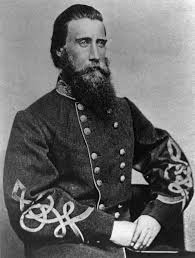    Major Van Dorn General Hood General Major General Smith General Fitzhugh Lee Major Van Dorn General Hood General Major General Smith General Fitzhugh Lee"This post was first begun on the Colorado River in 1856, but was shifted to the Jim Ned River, although it retained the original name. Built in 1857, in the stirring times of westward drift and Indian raid, the old post in its heyday sheltered notable men—Major Van Dorn, Captain Theodore O’Hara, whose poem, 'The Bivouac of the Dead' has thrilled the hearts of generations, General James B. Hood, General James P. Major, General Kirby Smith, and the famous General Fitzhugh Lee, nephew of General Robert E. Lee. From Camp Colorado went Major Van Dorn, first commander of the post, to Utah, in the days of the Mormon trouble. And from Camp Colorado went General James P. Major with the force under Van Dorn, and Captain Sol Ross, later Governor of Texas, on the expedition which resulted in the death of Peta Nocona, the last great Comanche war chief, and the capture of his white wife, Cynthia Ann Parker, whose life-long captivity among the Indians forms one of the classics of the Southwest." -Robert E. Howard, "The Ghost of Camp Colorado"
In the third paragraph of "The Ghost of Camp Colorado," Howard lists off the many famous names associated with Camp Colorado, tying Major Van Dorn back to the popular poem "The Bivouac of the Dead" who was covered in a previous post on the epigraph. The "Mormon Trouble" for which Howard mentions is the well known "Mountain Meadows Massacre" in which Mormons settled in Utah were trying to keep non-Mormons out of the territory, as well as paying retribution for the death of Joseph Smith, convinced local Indians to attack the Fancher Wagon Train. When the Indians abandoned the siege, the Mormons dressed as Indians in order to terrorize the members of the wagon train, eventually leading the wagon party to their death.
The massacre still remains somewhat controversial today as can be see by various videos explaining the massacre in many different ways. Having taught about this particular event in American history, I'm attaching a video that tries to simply present the facts about the "Mormon Trouble."
|
|
|
|
Post by linefacedscrivener on Nov 6, 2020 15:57:52 GMT -5
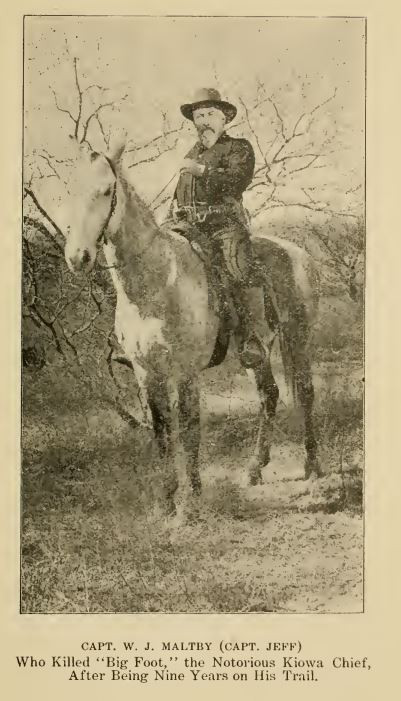 "When the clouds of Civil War loomed in the East and the boys in blue marched away from the post in 1861, their going did not end Camp Colorado’s connection with redskin history. For from the ranch-house and store built on the site of the post, Henry Sackett rode with Captain Maltby’s Frontier Battalion Rangers in 1874, on the path of Big Foot and Jape the Comanche, who were leaving a trail of fire and blood across western Texas. On Dove Creek, in Runnels County, which adjoins Coleman County on the west, the Rangers came up with the marauders and it was Henry Sackett’s rifle which, with that of Captain Maltby, put an end forever to the careers of Big Foot and Jape the Comanche, and brought to a swift conclusion the last Indian raid in central West Texas." -Robert E. Howard, "The Ghost of Camp Colorado" William Jeff Maltby (1829-1908) was born in Sangamon County, Illinois, on December 17, 1829. After a year's service as a volunteer in Gray's Battalion, Arkansas Volunteers, in 1846–47, he became a civilian employee of the United States Army in Fort Smith, Arkansas. From 1849 to 1855 Maltby served the army as a teamster, wagon-master, scout, and dispatch-bearer. He helped build several Texas frontier forts including Fort Belknap, Fort Clark, and Fort Concho. In 1856 at Fort Clark, Maltby operated a stage stop on the road from San Antonio to El Paso. He moved to Burnet County and married Mary Francis McKiney on June 7, 1857. During the Civil War Maltby served one year with the Seventeenth Texas Volunteer Infantry. In 1863 he returned home and organized neighbors into a minute men militia as a Texas Ranger sergeant to protect the area from raiding Indians. After a court martial initiated by Reconstruction officials in 1864, Maltby signed a Union loyalty oath and began ranching in partnership with G. C. Arnett in Burnet, Lampasas, Llano, and San Saba counties. He organized early cattle drives to Calvert, Texas, New Orleans, and Kansas. When the Frontier Battalion of the reorganized Texas Rangers was formed in 1874 under Maj. John B. Jones, Maltby was appointed commander of Company E. He served in this capacity from May 5 to December 13, 1874, and took part in the struggles between the Rangers and Indians and white desperadoes, those that Howard spoke of in his article. In 1875 he returned to Burnet County and moved his family to a Callahan County farm in 1878. In later years Maltby was a West Texas booster and well-known horticulturist. He accompanied the Texas Agricultural Exhibit to Chicago in 1891. Jeff and Mary Maltby had eight children. In 1906 he published Captain Jeff, which narrates his experiences as frontiersman, Texas Ranger, and Indian fighter. Link to Captain Jeff here: archive.org/details/captainjefforfro00malt/page/n5/mode/2upInformation above comes from the Texas Handbook Online. |
|
|
|
Post by linefacedscrivener on Nov 10, 2020 13:19:01 GMT -5
 "Of the original buildings of the post, only one remains—the guard house, a small stone room with a slanting roof now connected with the ranch-house. It was the only post building made of stone; the others, adobe-built, have long since crumbled away and vanished. Of the barracks, the officers’ quarters, the blacksmith shop, the bakery and the other adjuncts of an army camp, only tumbled heaps of foundation stones remain, in which can be occasionally traced the plan of the building. Some of the old corral still stands, built of heavy stones and strengthened with adobe, but it too is crumbling and falling down." -Robert E. Howard, "The Ghost of Camp Colorado"
The picture above is not of the guardhouse at Camp Colorado, but the one at Camp Mabry in Austin, Texas. It is typical construction, and fits Howard's description. According to Military Historian T.R. Havins, in his book Camp Colorado (Brown Press, 1964) , the first construction at Camp Colorado were the two guardhouses, though Howard only saw one when he visited. Havins writes: "The first construction activities concerned two guardhouses. With nine men under arrest when the troops arrived, provisions for holding them were necessary. Enlisted me from each company erected picket walls four feet above ground and daubed them with mud. Each had a stone chimney for heat, and an oval tent twelve by sixteen feet fastened atop the pickets served as a roof The nine prisoners spent one day idly under guard. Acute need for manpower would not warrant allowing prisoners to loaf in confinement, and for the next nine days they worked under guards and spent their nights in the guardhouses." In 1962, long after Howard's visit to Camp Colorado, a medallion marker was supposed to have been placed at the site of the remaining guardhouse, but as it is on private property, when my son and I visited, we were unable to locate it. |
|
|
|
Post by linefacedscrivener on Nov 11, 2020 13:41:05 GMT -5
 "The old guard house, which, with its single window, now walled up, forms a storeroom on the back of the Sackett house, has a vivid history all its own, apart from the military occupancy of the post. After the camp was deserted by the soldiers, it served as a saloon wherein the civilian settlers of the vicinity quenched their thirst, argued political questions and conceivably converted it into a blockhouse in event of Indian menace. One scene of bloodshed at least, it witnessed, for at its crude bar two men quarreled and just outside its door they shot it out, as was the custom of the frontier, and the loser of that desperate game fell dead there. "Today there remains a deep crevice in one of the walls where two military prisoners, confined there when the building was still serving as a dungeon, made a vain attempt to dig their way to liberty through the thick, solid stone of the wall. Who they were, what their crime was, and what implements they used are forgotten; only the scratches they made remain, mute evidence of their desperation and their failure." -Robert E. Howard, "The Ghost of Camp Colorado"
Howard continues to talk about the guard house at Camp Colorado from his visit and relays a few stories about the location. After the article was published in the Texaco Star, he asked Talman for additional copies of the magazine. He wanted to give them to the people who provided him the information on Camp Colorado, so perhaps these stories were ones shared by the old pioneers. Again, no pictures of the guard house exist, as far as I have been able to find, however, in Beatrice Grady Gay's "Into the Setting Sun": A History of Coleman County (1936) a drawing--the one above--was made by Mollie Grady Kelley, which depicts what the guard house looked like in about 1935, about five years after Robert E. Howard was there. |
|
|
|
Post by linefacedscrivener on Nov 12, 2020 13:47:17 GMT -5
 "In early days there was another saloon at the post, but of that building no trace today remains. Yet it was in use at least up to the time that Coleman County was created, for it was here that the first sheriff of the county, celebrating the gorgeous occasion of his election, emerged from the saloon, fired his six-shooter into the air and yelled: 'Coleman Country, by God, and I’m sheriff of every damn’ foot of her! I got the world by the tail on a downhill pull! Yippee!'” -Robert E. Howard, "The Ghost of Camp Colorado"
Continuing the review of Howard's "The Ghost of Camp Colorado," I looked around for more information on the saloon at Camp Colorado and found a few old timers mentioning the saloon. There does seem to be a difference though: During the military occupation, the mentions seems to be of an adobe saloon, like the adobe structure above. However, in the mentions by the Texas Rangers, they state that one of the guard houses was used as the saloon - now that would have been one small saloon! Gay's Into the Setting Sun book on the history of Coleman County states that the guardhouse was "a small room about ten by twelve, walls about eight inches thick, its one window overlooked the cuartel to the north, and its one door in the east." When she explains that one of the guard houses was used as a saloon, all of the information around it makes it pretty clear she is using Robert E. Howard's article as her source. I also tried looking to see who was the first sheriff of Coleman County with no luck. Great story by Howard though. |
|
|
|
Post by linefacedscrivener on Nov 13, 2020 13:31:49 GMT -5
 "A word in regard to the builder of the house that now represents Camp Colorado might not be amiss. The Honorable Henry Sackett was born in Orsett, Essexshire, England, in 1851 and came to America while a youth. Building the house, largely with his own labor, in 1870, he lived there until his death a few years ago, acting as postmaster under seven Presidents, and as store-keeper for the settlers. The south side of the stone house, built into a single great room, was used as post office and general store. Henry Sackett was a pioneer in the truest sense of the word, an upright and universally respected gentleman, a member of the Frontier Battalion of Rangers, and later Representative in the Legislature of Texas, from Brown and Coleman Counties. He married Miss Mary MacNamara, daughter of Captain Michael MacNamara of the United States Army. Mrs. Sackett still lives at Camp Colorado." -Robert E. Howard, "The Ghost of Camp Colorado"
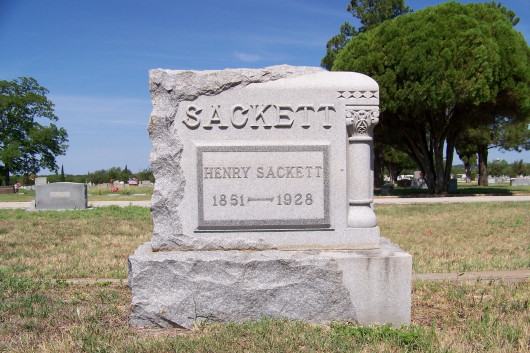
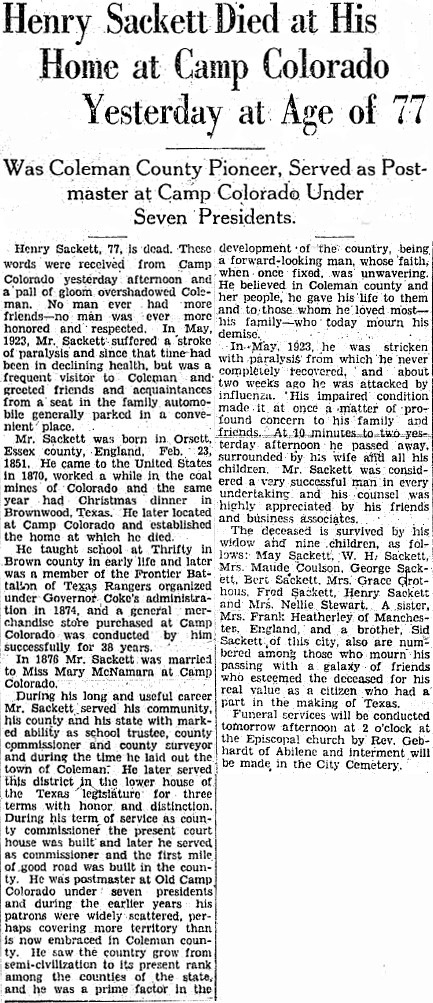
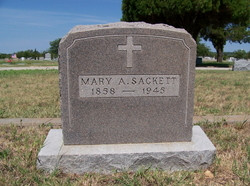
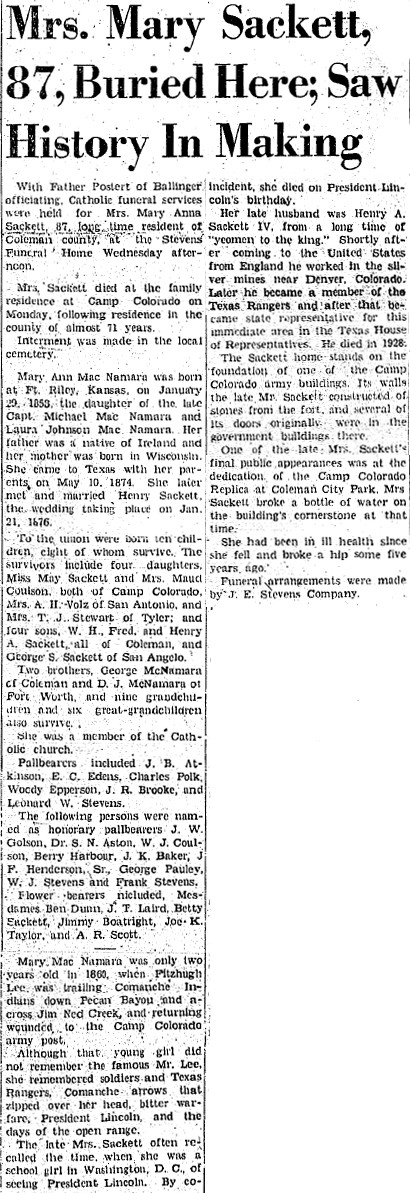 |
|
|
|
Post by linefacedscrivener on Nov 16, 2020 12:01:56 GMT -5
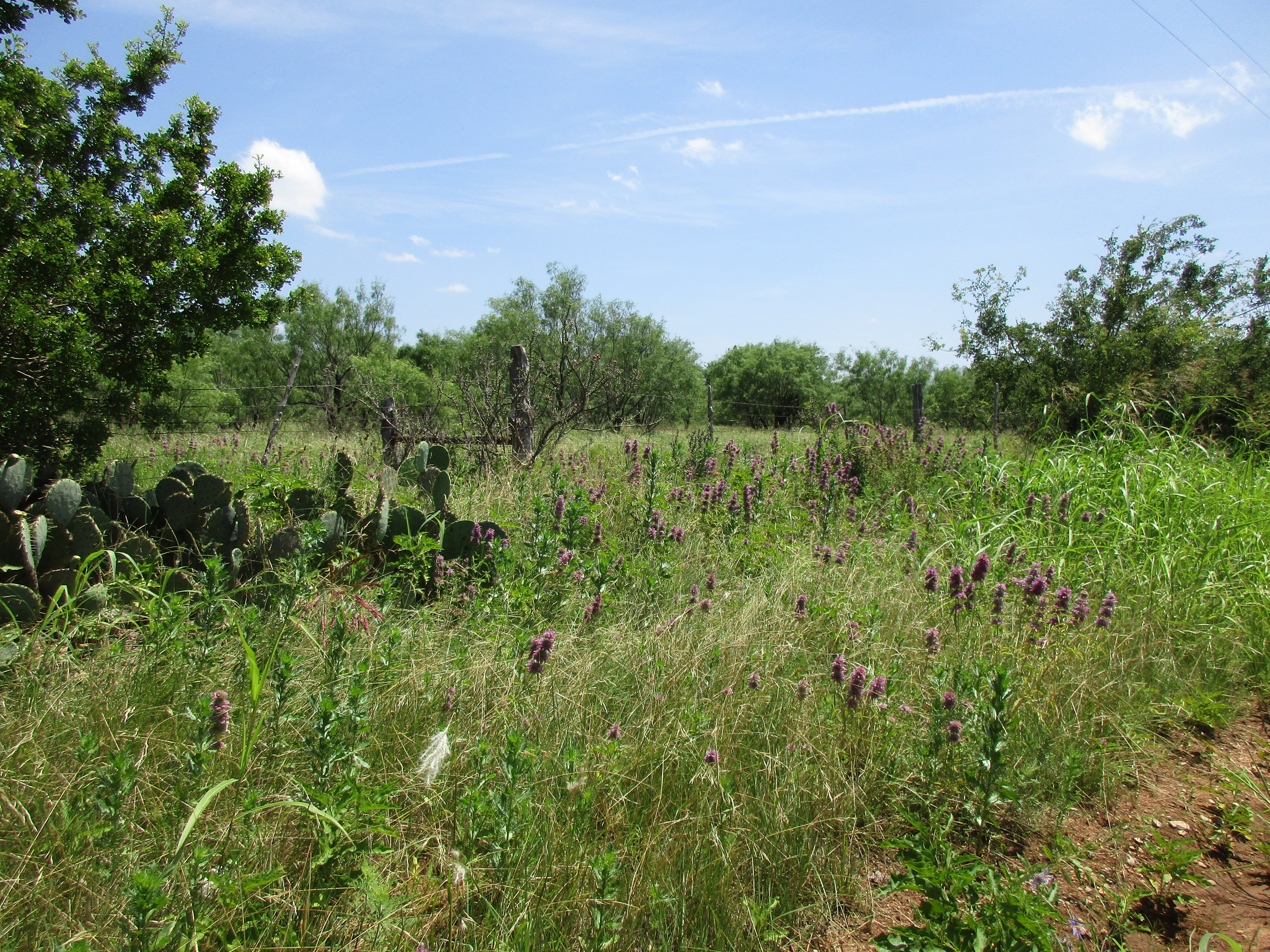 "The countryside is unusually picturesque—broad, rolling hills, thick with mesquite and scrub oaks, with the river winding its serpentine course through its narrow valley. On the slopes cattle and sheep graze and over all broods a drowsy quiet. But it is easy to resurrect the past in day dreams—to see the adobe walls rise out of dusty oblivion and stand up like ghosts, to hear again the faint and spectral bugle call and see the old corral thronged with lean, wicked-eyed mustangs, the buildings and the drill grounds with blue-clad figures—bronzed, hard-bitten men, with the sun and the wind of the open lands in their eyes—the old Dragoons! Nor is it hard to imagine that yonder chaparral shakes, not to the breeze, but to crawling, stealthy shapes, and that a painted, coppery face glares from the brush, and the sun glints from a tomahawk in a red hand. "But they have long faded into the night—the reckless, roistering cavalry men, the painted Comanches, the settlers in their homespun and buckskins; only the night wind whispers old tales of Camp Colorado." -Robert E. Howard, "The Ghost of Camp Colorado"
The picture above is one I took when I visited Camp Colorado last year with my son. As you drive into the area, it is a very narrow gravel road and both sides of the road are lined with high fence wire, clearly land set aside for deer leases. It was pretty overgrown, "thick with mesquite and scrub oaks." However, no sign of the river could be seen from the road and other than the marker located behind some of the fencing, there was not much there to signify the presence of the camp Robert E. Howard wrote about.
|
|
|
|
Post by linefacedscrivener on Nov 17, 2020 12:42:58 GMT -5
 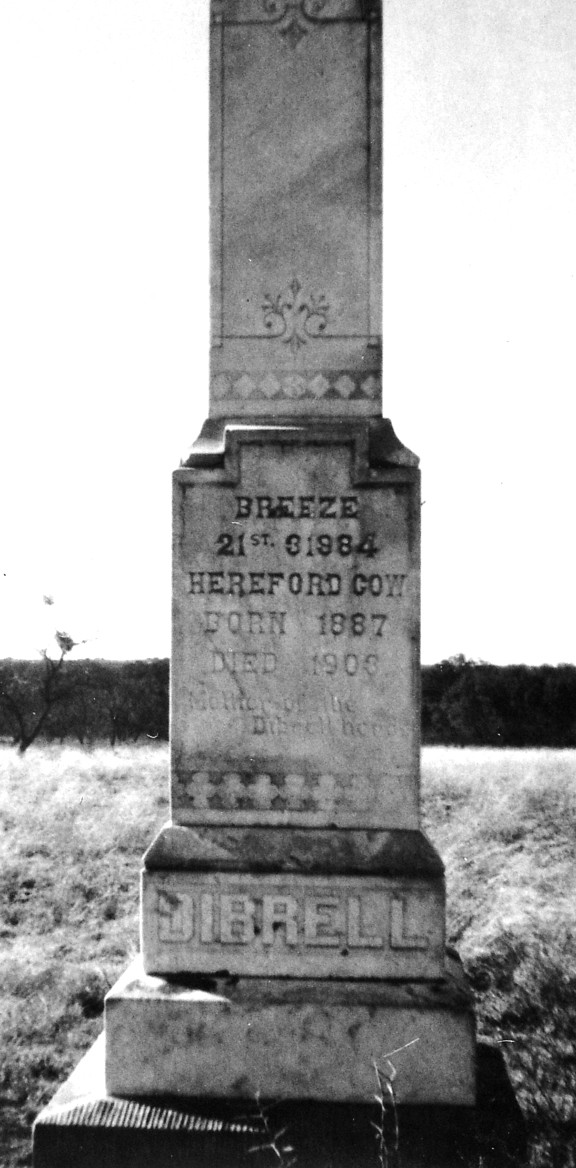 "A half mile perhaps from the Sackett house stands another remnant of the past—a sort of mile-stone, definitely marking the close of one age and the opening of another. It stands on a hillside in a corner of the great Dibrell ranch—a marble monument on which is the inscription: BREEZE 21ST 31984 HEREFORD COW BORN 1887 DIED 1903 MOTHER OF THE DIBRELL HERD DIBRELL "This monument marks the resting place of one of the first registered, short-horn cows of central West Texas. When Breeze was born, west Texas swarmed with half-wild longhorns, descendants of those cattle the Spaniards brought from Andalusia; now one might look far before finding one of those picturesque denizens of the old ranges. Fat, white faced, short horned Herefords of Breeze’s breed and kind have replaced them, and in the vast pageant of the west, the longhorn follows buffalo and Indian into oblivion." -Robert E. Howard, "The Ghost of Camp Colorado"This ends Howard's only non-fiction publication, "The Ghost of Camp Colorado," and what an interesting ending--an elaborate grave marker for a dead cow! The monument is actually on Find-A-Grave and the write up there gives a quick background on the marker: "This is one of the most unusual tombstones in Coleman County, as it marks the grave of a cow. It is located in a pasture, just west of the dirt road about one-half mile north of the Camp Colorado Cemetery. In 2013, this grave was located on private property. "William Carter Dibrell settled in the Camp Colorado area in 1883. He saw the need for improving his Longhorn cattle herd. While on a visit to the Texas State Fair in 1887, he bought four head of registered Hereford cattle from Gudgell and Simpson of Independence, Missouri. Of the four head of registered Hereford purchased, one bull died of tick fever before reaching the ranch and one cow choked to death chewing on a salt sack. The other cow, Breeze, was the base of the Dibrell Hereford herd. The herd grew from Breeze's heifers and new Hereford bulls, carefully selected in a period when registered cattle remained a novelty. None of Breeze's heifer calves were ever sold, always being retained to build up the herd. "The tombstone was erected after the Dibrell lot at the Coleman Cemetery was 'modernized,' a new stone being placed for W. C. Dibrell and the old stone being resurfaced, inscribed, and placed on the Dibrell Ranch for Breeze." And here is a link to an article that goes into a little more detail: archive.gosanangelo.com/business/homestead-dibrell-had-first-hereford-in-coleman-co-ep-503290297-354854531.html/ |
|
|
|
Post by linefacedscrivener on Nov 18, 2020 13:44:15 GMT -5
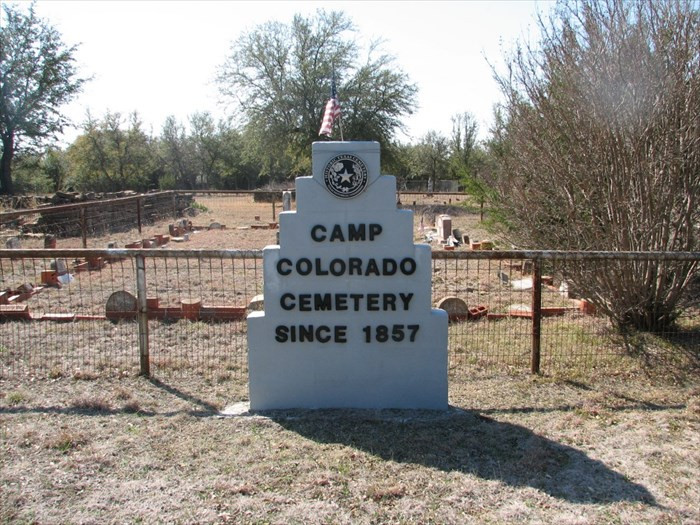 Yon marble minstrel's voiceless stone In deathless song shall tell, When many a vanquished ago has flown, The story how ye fell; Nor wreck, nor change, nor winter's blight, Nor Time's remorseless doom, Shall dim one ray of glory's light That gilds your deathless tomb.
—The Bivouac of the Dead
Interestingly, Howard did not mention the Camp Colorado Cemetery in his article "The Ghost of Camp Colorado." It is a little ways away from the location of the original camp, but not that far that he would not have known about it; at least, I believe. Although the cemetery is on private property today, it is still possible to access it, though it can prove difficult to find--you can't see it from the road. GPS would be good.
It is not known how many people are buried in the cemetery, but there is evidence for a little over 100 souls. Some of the earliest burials there were when it was a military camp, including Cpt Sidney Green Davidson, a member of Company F, Texas 1st Cavalry Regiment, who was killed by Indians. Later burials include many of the people who tried to settle the area around Camp Colorado. People are still being buried in the cemetery, one of the most recent being 2011.
The Cemetery has a listing on Find-A-Grave and here is the current list of known burials there: www.findagrave.com/cemetery/1992419/memorial-search?page=4#sr-83146547 |
|
|
|
Post by linefacedscrivener on Nov 19, 2020 11:20:31 GMT -5
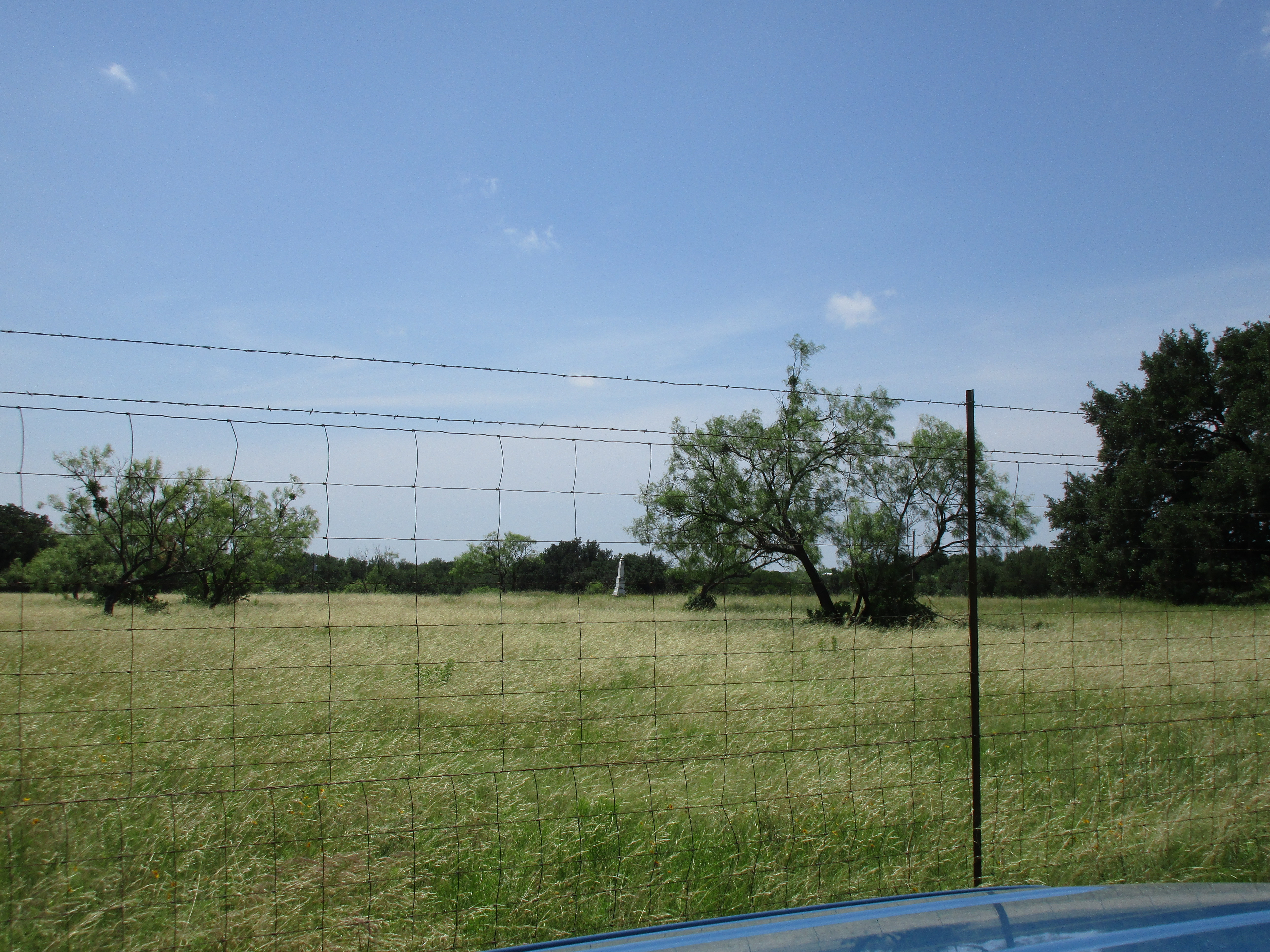 "On the banks of the Jim Ned River in Coleman County, central West Texas, stands a ghost." -Robert E. Howard, "The Ghost of Camp Colorado"
I decided to go ghost hunting with my son James last year, venturing out to Coleman County to visit Camp Colorado as Howard had done nearly 90 years ago. We passed over the bridge I detailed earlier and stopped to look around. We then loaded back up in the pickup truck and headed down the road. We got to the curve where the road turns north, so we stopped and again looked around. The biggest problem with finding anything was the fact that all along this dirt road were deer lease fences. Really high fencing ran all along the road, marking off property, and very rarely was there a gate open. We found one, went in and explored a little, but since we knew we were trespassing, we didn’t spend too long and we called out “hello” quite often. Finding nothing, we hopped back into the pickup and drove north, and continued scouting around. We consulted our maps and while we seemed to be too far north for the cemetery, that was when James called out – "We found it!" Way off in the distance, behind a normal wire fence was the graveyard--or so we thought (See picture above). We could see one of the markers sticking out of the ground. We then saw the entrance ahead and we both read, “Camp Colorado.” I pulled up to the gate, James hopped out of the pickup, and opened 'er up. I drove through, parked, and then hopped out to take a picture of the entrance to the cemetery. As I made my way over to the road to take a picture of the sign, James said, “That says ranch.” I turned around and looked at the sign posted over the gate that we had read as “Camp Colorado” and we saw that it actually read “Camp Colorado Ranch.” “Oh, shit!” was my natural response--we were on someone’s property. Knowing Texans quite well, I decided it was better for us to back out and close the gate, which we quickly did. Back in the pickup we turned to look at each other and busted out laughing. Ooops! We then drove alongside the gate and, standing in the pickup bed, I took a zoom picture of what we thought was the cemetery. It turns out it was the monument to Breeze the Hereford cow that Howard wrote about toward the end of “The Ghost of Camp Colorado.” |
|
|
|
Post by linefacedscrivener on Nov 20, 2020 12:01:49 GMT -5
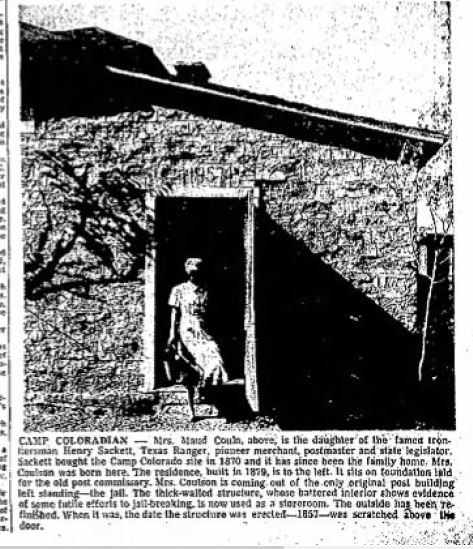 "Of the original buildings of the post, only one remains—the guard house, a small stone room with a slanting roof now connected with the ranch-house." -Robert E. Howard, "The Ghost of Camp Colorado"
I found it! I finally found a photo of the guard shack/house. This is what Robert E. Howard saw when he was there, and it is exactly like the drawing from the book on Coleman County that I wrote about in an earlier post.
I subscribe to newspaper.com for other research purposes and it dawned on me, I should trying searching for Camp Colorado in that database and, sure enough, I found a number of articles on the old camp.
Mrs. Maud Couln, shown in the picture, is the daughter of Henry Sackett who built the ranch house that connected to the guard house. Also, note the "1857" above the door, the year the guard house was built.
The article says it was used as a jail, which it was, but also as a guard house, command post, and saloon. A seriously multi-purpose stone building.
The newspaper clipping is from the Abilene-Reporter-News, dated Sunday, November 11, 1951.
|
|
|
|
Post by linefacedscrivener on Nov 24, 2020 12:06:46 GMT -5
 "Of the barracks, the officers’ quarters, the blacksmith shop, the bakery and the other adjuncts of an army camp, only tumbled heaps of foundation stones remain, in which can be occasionally traced the plan of the building." -Robert E. Howard, "The Ghost of Camp Colorado"
So, for my last post on Camp Colorado, I will mention that the year Robert E. Howard died, Coleman County built a replica of the Camp Colorado headquarters building. It was done so to participate in the Texas Centennial celebration and it received funding from the WPA. It still stands today, and serves as a sort of headquarters/maintenance office for the surrounding Coleman County park upon which it rests.
Here is what the website "The Living New Deal" has to say about the replica:
"Citizens of the City of Coleman and Coleman County desired to participate in the Texas Centennial in 1936. The idea was proposed to erect a replica of the administration building of old Camp Colorado in the City Park. The City Commissioners approved the proposal and proceeded with plans. Through the efforts of State Senator Walter Woodward of Coleman, a grant of $3600 was obtained from the Texas Centennial Commission and with these funds, and labor provided by the Works Projects Administration (WPA), the replica was erected. Many items of historical interest were displayed in the replica for the Centennial."
You can link to that website here: livingnewdeal.org/projects/camp-colorado-administration-building-replica-coleman-tx/
|
|
|
|
Post by linefacedscrivener on Nov 25, 2020 9:32:47 GMT -5
 “Some of the long argumentative & descriptive letters of our group really approach literature—the most remarkable ones coming from Robert E. Howard, whose reminiscences & historical sketches of his native Texas country are literature in the truest sense of the word, far more so than any save the very best of his stories.” -H.P. Lovecraft to R.H. Barlow, March 14, 1933 When it comes to Howard's writings about Texas, Lovecraft could not have been more accurate--so much of what Howard wrote about his native state comes from his letters, especially those to Lovecraft and August Derleth. In a sense, he really did write the beginnings of his book, An Unborn Empire. If you are interested in Howard and his writings about Texas, pick up a copy of the two volume set A Means to Freedom:smile.amazon.com/Means-Freedom-Letters-Lovecraft-Robert/dp/0984480293/ref=sr_1_1?dchild=1&keywords=A+means+to+Freedom&qid=1606314479&s=books&sr=1-1 |
|
|
|
Post by linefacedscrivener on Nov 25, 2020 11:09:41 GMT -5
 "You struck a responsive chord in me when you mentioned turkey dinner. Thanksgiving! Baked turkey, with dressing made of biscuit and cornbread crumbs, sage, onions, eggs, celery salt and what not; hot biscuits and fresh butter yellow as gold; rich gravy; fruit cakes containing citron, candied pineapple and cherries, currents, raisins, dates, spices, pecans, almonds, walnuts; pea salad; pumpkin pie, apple pie, mince pie with pecans; rich creamy milk, chocolate, or tea - my Southern ancestors were quite correct in adopting the old New England holiday." -Robert E. Howard to H.P. Lovecraft, December 1932
Happy Thanksgiving everyone! |
|























